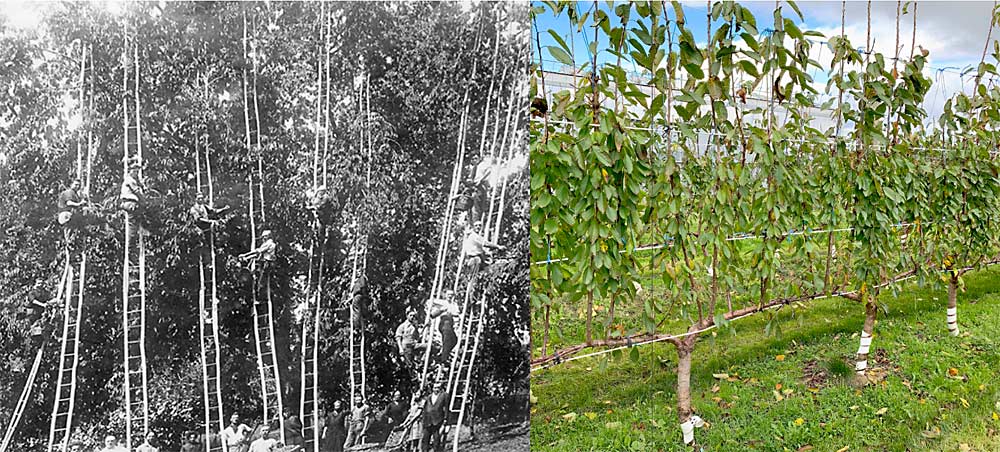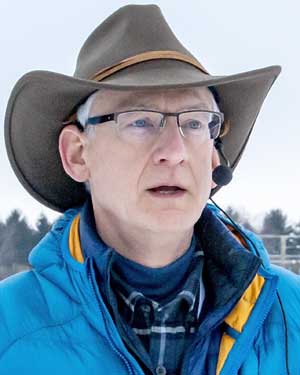
In its natural habitat, a sweet cherry tree can grow up to 135 feet, much higher than an apple tree’s 40 feet, or even a pear tree’s 65 feet. Combine that height with small, delicate fruit that needs to be picked by the stem, and it’s safe to say the cherry tree poses some unique management challenges.
“It’s a forest tree,” said Greg Lang, a professor of horticulture at Michigan State University. Lang spoke during the International Fruit Tree Association’s 2020 conference in Grand Rapids, Michigan. “It evolved over centuries to survive in forests.”
But over the last few decades, researchers, nurserymen and growers have manipulated the giant forest tree’s physiology into the small yet productive tree we see in modern, high-density orchards today. Cherry trees, it turns out, can grow into unusual shapes. Lang focused especially on the UFO system — upright fruiting offshoots — named by Matt Whiting, a Washington State University professor.
Lang expects the UFO system to be common a decade from now. Its yields can be equal to or greater than other systems, crop load management and fruit quality are more uniform, hand harvest is more efficient, and the structure is more amenable to precision tools and technology.
But how did we get from there to here — from the forest giant to the UFO? Lang started by explaining how a seedling survives.
A cherry seedling’s top priority is to grow a vertical leader that can capture as much light as possible in a crowded forest. To achieve apical dominance, all of the tree’s energy and growth goes toward its top in the first year, he said.

“Vigor is always greatest in the tops of trees,” Lang said. “Even when they are 35 or more years old.”
Beginning in the second year, the leader keeps growing, but the tree also initiates upright primary lateral growth just below it (so if the leader dies, one of the laterals can take over). Lower secondary branches grow horizontally beneath the primary laterals, to capture light the leader isn’t getting — and to shade out forest competitors, he said.
As the tree ages, its extreme vigor is dispersed into the laterals. In order to capture new light, its large leaves arise as far away from the previously formed leaves as possible.
“(The cherry tree) still thinks it’s in the forest and (it is) trying to grow up and capture light,” Lang said. “That’s what we’re trying to manage throughout the life of the orchard.”
For a long time, commercial growers had to focus on managing a freestanding cherry tree’s incredible vigor — keeping it at a reasonable size — rather than managing its crop load. Things changed in the 1990s, however, when dwarfing rootstocks became available.
“The question we started wrestling with when we got dwarfing rootstocks for sweet cherries was: How can we get toward precise crop load management of a cherry tree now that we have a smaller tree than that forest tree?” Lang said.
He turned to grapevines for inspiration.
“I said, ‘Let’s grow a cherry tree like a grape, where it is easy to prune to a specific number of spurs and buds that lead to a specific spacing and quantity of shoots and fruit clusters.’”
With this in mind, in 1999, Lang, who was with WSU at the time, developed a planar cherry tree canopy structure to emulate the two cordons and vertical shoot position training of wine grapes. WSU’s Whiting further developed the concept with UFO — a system that utilizes the natural growth habit the cherry tree evolved over centuries to most efficiently capture sunlight, Lang said.
UFO takes advantage of the tree’s natural upright growth by establishing multiple vertical fruiting units in a narrowly aligned row arising from a primary trunk that’s trained horizontally. The number of vertical fruiting units is varied to diffuse vigor in proportion to the overall vigor of the rootstock-scion-soil-climate matrix — yielding the only training system that can be adapted to any rootstock. The system also takes advantage of the leaves’ natural arrangement — forming on the vertical shoot as far away, horizontally, from previous leaves as possible — to minimize shading and maximize light penetration, Lang said. •
—by Matt Milkovich
Related:
—Precision vision on 2020 IFTA Michigan tour
—Still no answer for bitter pit
—Battle of the cherry architectures
—Growers gain UFO experience






Leave A Comment